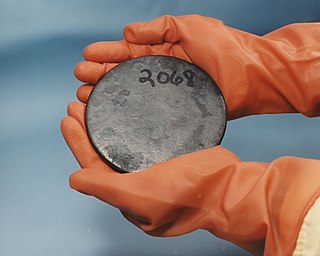Related Research Articles

"Little Boy" was the code name for the type of atomic bomb dropped on the Japanese city of Hiroshima on 6 August 1945 during World War II. It was the first nuclear weapon used in warfare. The bomb was dropped by the Boeing B-29 Superfortress Enola Gay piloted by Colonel Paul W. Tibbets, Jr., commander of the 509th Composite Group of the United States Army Air Forces. It exploded with an energy of approximately 15 kilotons of TNT (63 TJ) and caused widespread death and destruction throughout the city. The Hiroshima bombing was the second nuclear explosion in history, after the Trinity test, and the first uranium-based detonation.

Uranium is a chemical element with symbol U and atomic number 92. It is a silvery-grey metal in the actinide series of the periodic table. A uranium atom has 92 protons and 92 electrons, of which 6 are valence electrons. Uranium is weakly radioactive because all isotopes of uranium are unstable, with half-lives varying between 159,200 years and 4.5 billion years. The most common isotopes in natural uranium are uranium-238 and uranium-235. Uranium has the highest atomic weight of the primordially occurring elements. Its density is about 70% higher than that of lead, and slightly lower than that of gold or tungsten. It occurs naturally in low concentrations of a few parts per million in soil, rock and water, and is commercially extracted from uranium-bearing minerals such as uraninite.

Depleted uranium is uranium with a lower content of the fissile isotope U-235 than natural uranium. Natural uranium contains about 0.72% U-235, while the DU used by the U.S. Department of Defense contains 0.3% U-235 or less. Uses of DU take advantage of its very high density of 19.1 g/cm3. The less radioactive and non-fissile uranium-238 constitutes the main component of depleted uranium.

Tuberculosis verrucosa cutis is a rash of small, red papular nodules in the skin that may appear 2–4 weeks after inoculation by Mycobacterium tuberculosis in a previously infected and immunocompetent individual.

Blue nevus is a type of melanocytic nevus. The blue colour is caused by the pigment being deeper in the skin than in ordinary nevi. In principle they are harmless but they can sometimes be mimicked by malignant lesions, i.e. some melanomas can look like a blue nevus.
Lymphomatoid papulosis (LyP) is a rare skin disorder. The overall prevalence rate of lymphomatoid papulosis is estimated at 1.2 to 1.9 cases per 1,000,000 population. This rare condition has only been studied in depth since 1968.
Plummer's nail is a clinical sign in which there is onycholysis, or separation of the nail from the nail bed, particularly affecting the ring and little fingers. It occurs in patients with thyrotoxicosis. About 5% of hyperthyroid patients display abnormal nail changes. Plummer's nail is also associated with psoriasis, traumatic injury, and allergic contact dermatitis.
Paraneoplastic acrokeratosis, Bazex syndrome is a cutaneous condition characterized by psoriasiform changes of hands, feet, ears, and nose, with involvement of the nails and periungual tissues being characteristic and indistinguishable from psoriatic nails. The condition is associated with carcinomas of the upper aerodigestive tract.

Cutaneous lymphoid hyperplasia refers to a groups of benign cutaneous disorders characterized by collections of lymphocytes, macrophages, and dendritic cells in the skin. Conditions included in this groups are:
Mucosal melanoma is a rare cutaneous condition characterized by a melanoma of the mucous membranes.
Median raphe cysts are a cutaneous condition of the penis due to developmental defects near the glans.
Infantile acne is a cutaneous condition that presents at 3 to 6 months of age.
Alopecia neoplastica may present as a scarring alopecia, appearing anywhere on the scalp, and it has been described with cutaneous metastasis from breast, gastric, lung, renal and pancreatic carcinomas.

A Myxoid cyst is a cutaneous condition often characterized by nail plate depression and grooves.
Hair follicle nevus is a cutaneous condition that presents as a small papule from which fine hairs protrude evenly from the surface.
Traumatic alopecia is a cutaneous condition that results from the forceful pulling out of the scalp hair.
Drug-induced keratoderma is a cutaneous condition characterized by a hornlike skin texture.
Shabbir syndrome is a cutaneous condition inherited in an autosomal recessive fashion.
Metageria is a cutaneous condition characterized by premature aging.
Limb–mammary syndrome is a cutaneous condition characterized by p63 mutations.
References
- ↑ Rapini, Ronald P.; Bolognia, Jean L.; Jorizzo, Joseph L. (2007). Dermatology: 2-Volume Set. St. Louis: Mosby. p. 1366. ISBN 978-1-4160-2999-1.
| This cutaneous condition article is a stub. You can help Wikipedia by expanding it. |